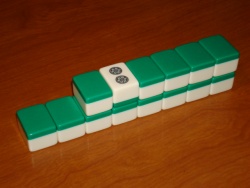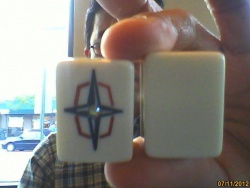Dora: Difference between revisions
m (→Wanpai) |
m (→Akadora) |
||
| Line 43: | Line 43: | ||
===Akadora=== | ===Akadora=== | ||
[[Image:Dora Haku.jpg|250px|right|thumb|Specially marked haku as dora, next to a standard haku tile.]] | [[Image:Dora Haku.jpg|250px|right|thumb|Specially marked haku as dora, next to a standard haku tile.]] | ||
[[Image:Kandora.png|250px|right|thumb|Multiple dora shown due to [http://tenhou.net/0/?log=2014081810gm-0009-7447-935af6c5&tw=1&ts=5 kan calls].]] | |||
'''Akadora''' {{kana|赤ドラ}} or '''akapai''' {{kana|赤牌}} are specifically marked red dora tiles. If included in the game, these "red fives" automatically count as dora, regardless of the dora indicator. If the dora indicator is a four, the red five of the same suit counts as two dora. Some tile sets may mark other tiles as red dora. | '''Akadora''' {{kana|赤ドラ}} or '''akapai''' {{kana|赤牌}} are specifically marked red dora tiles. If included in the game, these "red fives" automatically count as dora, regardless of the dora indicator. If the dora indicator is a four, the red five of the same suit counts as two dora. Some tile sets may mark other tiles as red dora. | ||
Revision as of 07:37, 18 August 2014

Dora 「ドラ」 is a feature to the game, where possession of specific tiles instantly grants the hand 1 han per tile. Regardless, hands must still possess a yaku in order to score, regardless of the number of dora in the hand. At the start of every hand, 14 tiles are set aside as the wanpai, or dead wall tiles. Furthermore, additional dora may be revealed through the use of uradora and/or kandora.
Wanpai
Wanpai 「王牌」 are the tiles used to form the dead wall. These tiles are set aside from the regular draw and discard play. These are generally inaccessible, unless players call kan. At all time, the dead wall must be maintained at 14 tiles. In the event of a kan call, a tile is drawn by the player, and so a replacement tile from the end of the regular wall is added to the end of the dead wall.
Every mahjong hand session has 14 tiles set aside from the regular tile draw and discard processes. These tiles are considered to be out of play, hence the nomenclature "dead wall". Among the dead wall, one tile is flipped and revealed for everyone. This tile is assigned as the dorahyouji 「ドラ表示」, or "dora indicator". Tiles marked as dora are indicated as the next tile in the sequence.
For example, if the dora indicator shows ![]() , then the dora tile is
, then the dora tile is ![]() .
.
The dead wall also holds the rinshanpai 「嶺上牌」, which are only accessible via calls for kan. They are the four tiles between the dora indicator and the first cut of the wall. In other words, they are the four tiles immediately clockwise from the dora indicator. Winning tiles from this draw invokes the yaku, rinshan kaihou.
Dora order
This lists the complete dora order. As a repeat, the dora is the next tile within each of the following orders. Dora are not "cross indicated" among the different suits. Furthermore, the dora order loops.
Suit order
Wind order
Dragon order
Duplicated dora
In the event a dora indicator is repeated, either as a kandora or uradora, then the dora tile is worth the number of han as the dora indicator shows.
Example:
- Dora indicators
Other types of dora
Additional indicators of dora may be found in the game.
Akadora


Akadora 「赤ドラ」 or akapai 「赤牌」 are specifically marked red dora tiles. If included in the game, these "red fives" automatically count as dora, regardless of the dora indicator. If the dora indicator is a four, the red five of the same suit counts as two dora. Some tile sets may mark other tiles as red dora.
Other tiles may also be marked "red" as automatic dora. Five happens to be the common choice because it is the center number within the 1 through 9 range. Though rarely found, some older sets include a "red haku" tile (white dragon).
Uradora
Uradora 「裏ドラ」, or underneath dora applies only to hands won using riichi. Thus, no open hand may ever have access to the uradora. In the event a riichi declared hand has won, the tiles underneath the dora indicator(s) are revealed. These newly revealed tiles serve as additional dora indicators. Potentially, such hands may potentially gain substantial value, just off of the uradora.
If there are multiple identical indicators, each indicated tile counts as multiple dora correspondingly.
Kandora
After a call for kan, additional dora indicators, called kandora 「カンドラ」, are revealed. These are tiles next to the dora indicator counter clockwise on the dead wall. Depending on the rules and/or formality of the game, the timing for flipping the kandora during a kan procedure may vary. Casual games will simply flip the kan dora immediately after kan. More technical games will differentiate between the kan types, where the kan dora may be flipped after the player makes a discard.
Likewise, in the event of riichi, the uradora underneath the kandora are also revealed, as kanuradora.
Nukidora
In some rules of three-player mahjong, North tiles may be picked. The procedure is the same of forming a added kan. The North tiles picked becomes doras.
External links
- Dora in Japanese Wikipedia